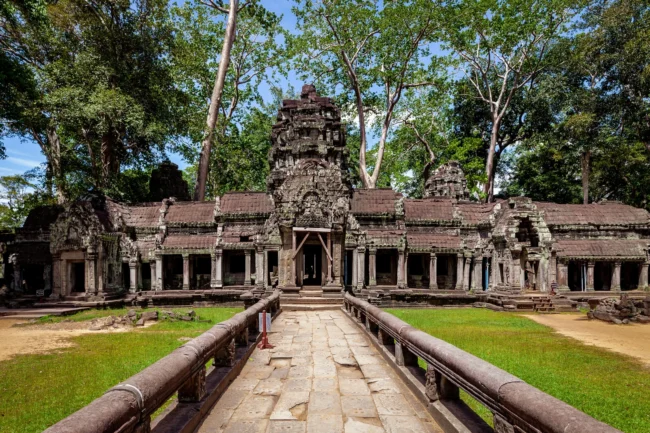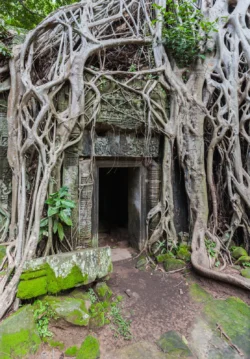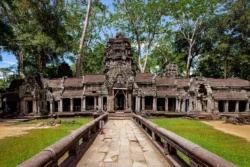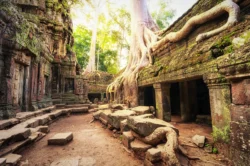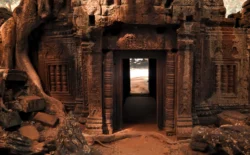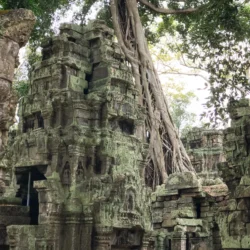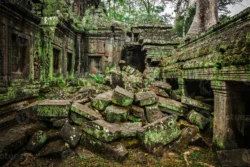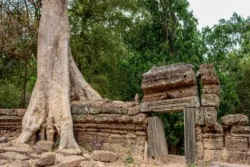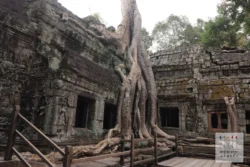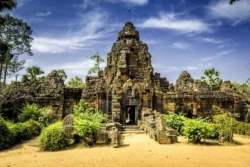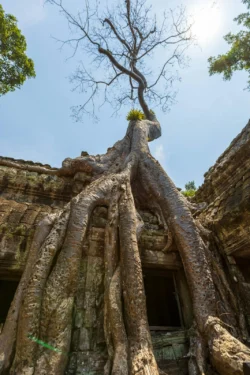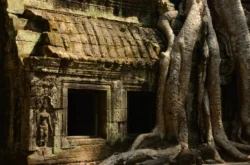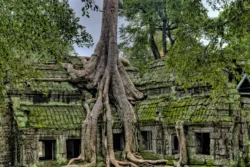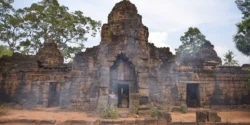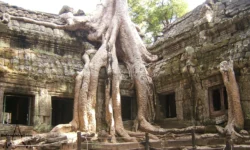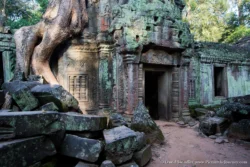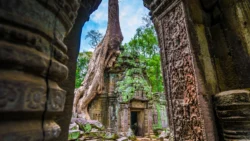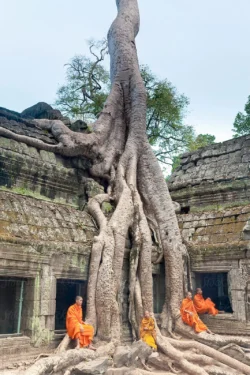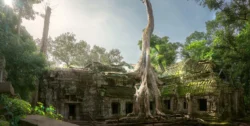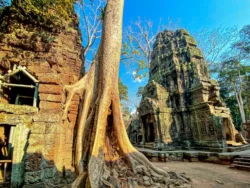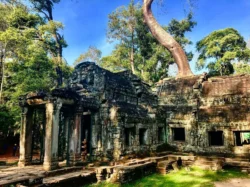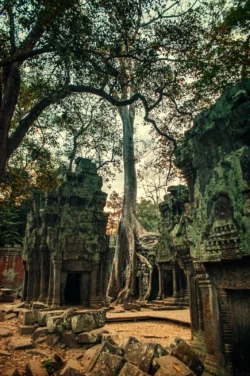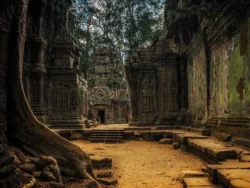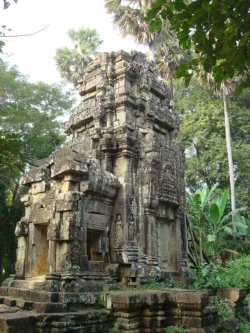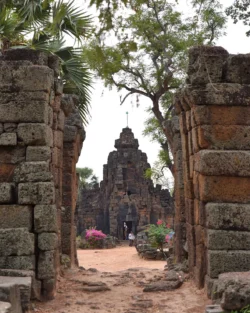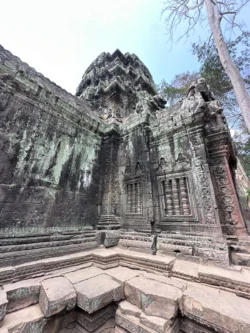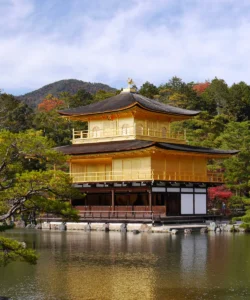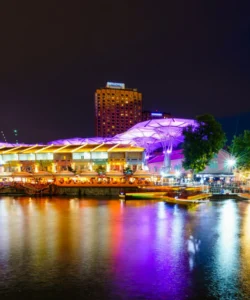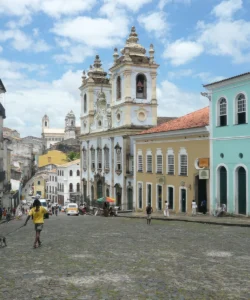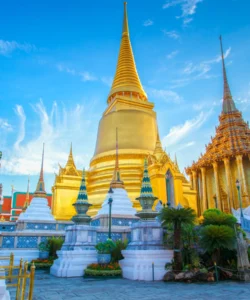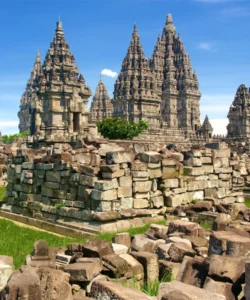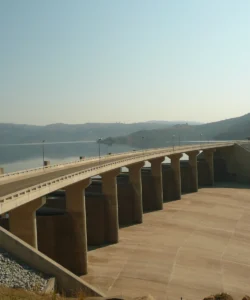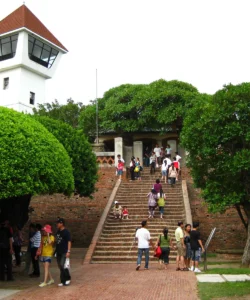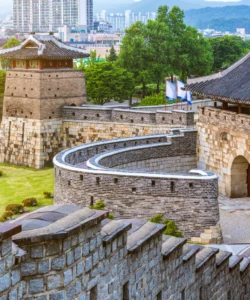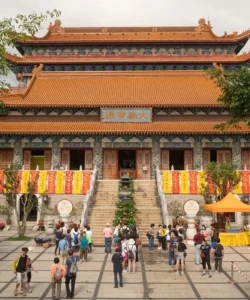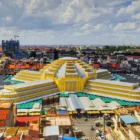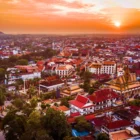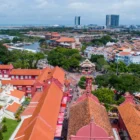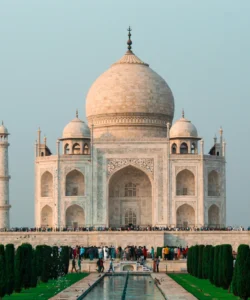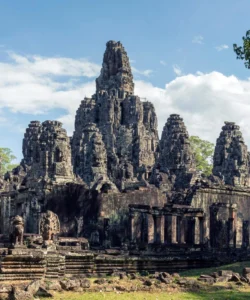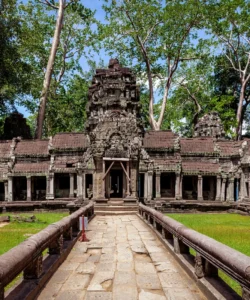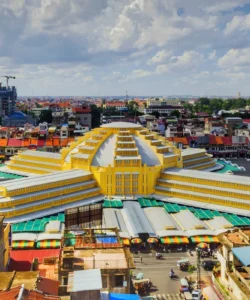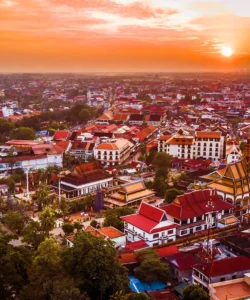Ta Prohm is one of the most iconic and atmospheric temples within the vast Angkor Archaeological Park in Cambodia. Unlike many of its meticulously restored counterparts, Ta Prohm has been deliberately left in much of the “wild” state in which it was rediscovered, allowing visitors to witness the incredible power of nature reclaiming ancient man-made structures. This unique fusion of crumbling stone and gigantic tree roots makes it a mesmerizing and highly photogenic site.
Name: Ta Prohm (Khmer: ប្រាសាទតាព្រហ្ម, meaning “Ancestor Brahma”). It was originally called Rajavihara (Khmer: រាជវិហារ, meaning “Royal Monastery”). It is widely known as the “Tomb Raider Temple” due to its feature in the film “Lara Croft: Tomb Raider” (2001).
Address: Ta Prohm is located approximately one kilometer east of Angkor Thom and on the southern edge of the East Baray, within the larger Angkor Archaeological Park. It is about 12 kilometers (7.5 miles) northeast of Siem Reap city, in Siem Reap Province, Cambodia.
How to Get There:
Access to Ta Prohm, like other temples in the Angkor Archaeological Park, is typically from Siem Reap.
- From Siem Reap City:
- Tuk-tuk (Recommended): This is the most popular and atmospheric way to visit. You can hire a tuk-tuk driver for a full day (or multiple days) to take you around the “Small Circuit” route, which includes Ta Prohm, Angkor Wat, and Angkor Thom. The drive from Siem Reap to Ta Prohm takes around 20-30 minutes.
- Taxi/Private Car with Driver: Offers more comfort and air-conditioning, especially useful in the heat. Easily arranged through hotels or local services.
- Bicycle/Electric Bike: For the fit and adventurous, cycling is possible, as the roads are generally sealed. However, the entire Angkor complex is vast, and cycling between all temples can be tiring.
- Ride-Hailing Apps (Grab, PassApp): Widely used for hiring taxis or tuk-tuks.
- Angkor Pass: A valid Angkor Pass is required to enter Ta Prohm and all other temples within the Angkor Archaeological Park. These can be purchased in 1-day, 3-day, or 7-day options from Angkor Enterprise (the official ticket office) or online.
Landscape and Architecture:
Ta Prohm’s architecture is a classic example of Bayon-style Khmer temple construction, but its fame lies in its dramatic interaction with the surrounding jungle.
- “Jungle Temple” Aesthetic: The defining characteristic of Ta Prohm is that it has been intentionally left in a partially unrestored state, allowing enormous strangler fig and kapok trees to grow directly out of, on top of, and through its stone structures. Their massive, serpentine roots cascade over walls, entwine around doorways, and embrace crumbling foundations, creating a surreal and hauntingly beautiful scene where nature and man-made structures merge. This deliberate preservation strategy offers a glimpse into what Angkor’s temples looked like when first “rediscovered” in the dense jungle.
- Flat Temple Layout: Ta Prohm is a “flat” temple, built on ground level without a significant elevated pyramid structure (unlike Angkor Wat, which is a temple-mountain). It features a traditional Khmer structure of five concentric rectangular enclosures surrounding a central sanctuary.
- Galleries, Towers, and Courtyards: The complex consists of a series of interconnected one-story buildings, including galleries, rooms, towers (prasats), libraries, narrow corridors, and shaded courtyards.
- Bas-Reliefs: Like other Khmer temples, Ta Prohm is adorned with intricate bas-reliefs and statues. While some have decayed due to the jungle’s encroachment or later religious shifts, many detailed carvings of Hindu deities, Buddhist mythology, Apsaras, and daily life scenes remain.
- Sandstone Construction: The temple is primarily constructed from sandstone, meticulously cut and fitted together without mortar, a testament to ancient Khmer engineering.
- Moats and Outer Walls: The outermost enclosure measures approximately 1000m by 700m, originally encompassing a substantial town, now largely forested. There were also moats, reflecting the typical Khmer temple complex design.
- Face Towers: Some of the gopuras (entrance gates) feature monumental smiling faces similar to those found at the Bayon temple, although some have collapsed over time.
- Wooden Walkways and Metal Supports: To manage visitor flow and protect fragile areas, wooden walkways, rope fences, and discreet metal supports have been added during conservation efforts.
What Makes It Famous:
- “Nature vs. Architecture” Symbiosis: Ta Prohm is globally famous for the dramatic and picturesque interplay between its ancient stone ruins and the colossal tree roots that seemingly consume and hold the temple together. This unique aesthetic is unparalleled among Angkor’s temples and makes it a must-see for photographers and nature lovers.
- “Tomb Raider Temple”: Its appearance in the 2001 film “Lara Croft: Tomb Raider,” starring Angelina Jolie, significantly boosted its international fame and brought it to a wider global audience.
- Deliberate Unrestored State: The decision by archaeologists to leave Ta Prohm largely as it was found, emphasizing its “lost in the jungle” charm, sets it apart from more fully restored temples like Angkor Wat. This offers a more raw and immersive experience of discovery.
- Mystical and Atmospheric Ambiance: The intertwining roots, crumbling walls, and dappled light filtering through the dense canopy create a haunting, mysterious, and deeply atmospheric feel, evoking a sense of ancient exploration.
- Buddhist Monastery and University: Historically, it was a significant Mahayana Buddhist monastery and university, dedicated by King Jayavarman VII to his mother, highlighting its spiritual and educational importance during the Khmer Empire.
- Part of UNESCO World Heritage Site: As a key component of the Angkor Archaeological Park, Ta Prohm is part of a UNESCO World Heritage Site, recognized for its outstanding universal value.
Differences from Some Other Wonders:
- Natural Overgrowth as a Feature: The most significant difference from other temples (like Angkor Wat or Borobudur, which are largely cleared and restored) is Ta Prohm’s deliberate preservation of the jungle’s embrace. This active integration of nature into the architectural experience is its unique selling point.
- Absence of Temple-Mountain Structure: Unlike Angkor Wat or Borobudur, which are built as ascending temple-mountains, Ta Prohm is a flat temple with a series of concentric enclosures, offering a different spatial experience.
- Less Focus on Narrative Bas-Reliefs (compared to Angkor Wat/Prambanan): While it has carvings, the quantity and narrative continuity of bas-reliefs are less central to Ta Prohm’s fame than at Angkor Wat or Prambanan. The focus shifts more to the interaction between stone and root.
- “Picturesque Ruin” Aesthetic: Ta Prohm embodies the “picturesque ruin” aesthetic more fully than other Angkor temples, appealing to a sense of romantic decay and the power of nature over human creations.
- Film Connection: Its direct and famous connection to a major Hollywood movie (“Tomb Raider”) provides a specific pop culture association that is less prominent for most other ancient wonders.
- Bayon-Style Features: As a temple built by Jayavarman VII, it shares the general Bayon architectural style, including some face towers on its gopuras, linking it stylistically to temples within Angkor Thom like the Bayon itself.
Ta Prohm Temple Photos:
